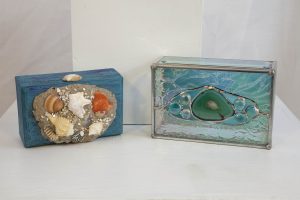Diana Schleicher often starts a stained glass project — such as a sun catcher or mosaic piece — by allowing the glass itself to suggest a subject. Sometimes it’s a landscape, a bird or insect or some kind of geometric design.
 “The texture of the glass and the way the light filters through is what first sparks my interest,” she says. “I particularly like incorporating shells, beads and natural materials in the design.”
“The texture of the glass and the way the light filters through is what first sparks my interest,” she says. “I particularly like incorporating shells, beads and natural materials in the design.”
Her interest in stained glass began when she took a BOCES class more than 20 years ago when she found a local stained glass instructor. Working alongside three other students, she began going weekly to improve her skills.
But long before that first class, she was interested in art, even as a child. She studied Advertising Art and Design at the State University Agricultural and Technical Institute in Farmingdale, Long Island. Although Advertising Art wasn’t for her, she enjoyed calligraphy and later used it to create signs and posters in the various places she was employed.
As an Occupational Therapy Assistant at Pilgrim State Hospital on Long Island, her interest in art developed into a desire to try various crafts.
“I worked in several Occupational Therapy ‘shops’ with psychiatric patients in the areas of weaving, ceramics, woodworking and embroidery. I was learning as much from the patients I worked with as well as other staff,” she says. Hoping to continue working in the human service field when she moved upstate in 1977, she got a job at Community, Work and Independence and has been there 35 years.
“I was one of the original members when VAM first began. I made soft-sculptured character dolls at the time, more as a hobby. It was a new experience for me, to be around other successful artists. I later moved on to decorating boxes with birch bark and twigs from the woods behind my house. I loved using materials in nature to create usable items.”
Diana’s biggest challenge with stained glass is having the time and space to make it. Also, stained glass is unforgiving. “Unfortunately, if you make a mistake in stained glass, you either have to take it apart, or replace broken pieces. Each step is challenging, cutting glass the wrong way results in pieces of glass in shapes you can’t use. Soldering those pieces together, so your finished piece looks neat, is also challenging. This can be costly and time consuming. Having a full time job and limited work space at my house — the kitchen table — doesn’t allow me to produce as much as I’d like to,” she says. “In the future, I hope to improve my skills, and learn new techniques with glass, such as jewelry making, etching, and the use of a kiln.”
